
Michelangelo di Lodovico Buonarroti Simoni, known as Michelangelo, was an Italian sculptor, painter, architect, and poet of the High Renaissance. Born in the Republic of Florence, his work was inspired by models from classical antiquity and had a lasting influence on Western art. Michelangelo's creative abilities and mastery in a range of artistic arenas define him as an archetypal Renaissance man, along with his rival and elder contemporary, Leonardo da Vinci. Given the sheer volume of surviving correspondence, sketches, and reminiscences, Michelangelo is one of the best-documented artists of the 16th century. He was lauded by contemporary biographers as the most accomplished artist of his era.
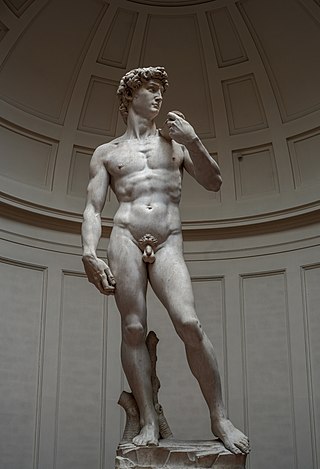
David is a masterpiece of Italian Renaissance sculpture, created from 1501 to 1504 by Michelangelo. With a height of 5.17 metres, the David was the first colossal marble statue made in the early modern period following classical antiquity, a precedent for the 16th century and beyond. David was originally commissioned as one of a series of statues of prophets to be positioned along the roofline of the east end of Florence Cathedral, but was instead placed in the public square in front of the Palazzo della Signoria, the seat of civic government in Florence, where it was unveiled on 8 September 1504. In 1873, the statue was moved to the Galleria dell'Accademia, Florence, and in 1910 replaced at the original location by a replica.

The Papal Basilica of Saint Peter in the Vatican, or simply Saint Peter's Basilica, is a church built in the Renaissance style located in Vatican City, the papal enclave that is within the city of Rome, Italy. It was initially planned by Pope Nicholas V and then Pope Julius II to replace the aging Old St. Peter's Basilica, which was built in the fourth century by Roman emperor Constantine the Great. Construction of the present basilica began on 18 April 1506 and was completed on 18 November 1626.
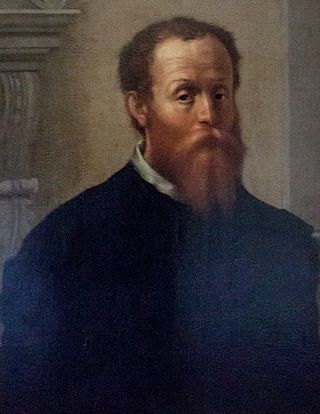
Baccio Bandinelli, was an Italian Renaissance sculptor, draughtsman, and painter.
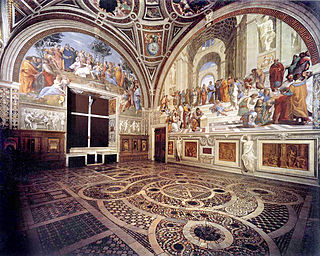
In art history, the High Renaissance was a short period of the most exceptional artistic production in the Italian states, particularly Rome, capital of the Papal States, and in Florence, during the Italian Renaissance. Most art historians state that the High Renaissance started around 1495 or 1500 and ended in 1520 with the death of Raphael, although some say the High Renaissance ended about 1525, or in 1527 with the Sack of Rome by the army of Charles V, Holy Roman Emperor, or about 1530. The best-known exponents of painting, sculpture and architecture of the High Renaissance include Leonardo da Vinci, Michelangelo, Raphael, and Bramante. In the 21st century, the use of the term has been frequently criticized by some academic art historians for oversimplifying artistic developments, ignoring historical context, and focusing only on a few iconic works.

The Galleria dell'Accademia di Firenze, or "Gallery of the Academy of Florence", is an art museum in Florence, Italy. It is best known as the home of Michelangelo's sculpture David. It also has other sculptures by Michelangelo and a large collection of paintings by Florentine artists, mostly from the period 1300–1600. It is smaller and more specialized than the Uffizi, the main art museum in Florence. It adjoins the Accademia di Belle Arti or academy of fine arts of Florence, but despite the name has no other connection with it.

The Madonna of the Stairs is a relief sculpture by Michelangelo in the Casa Buonarroti, Florence. It was sculpted around 1490, when Michelangelo was about fifteen. This and the Battle of the Centaurs were Michelangelo's first two sculptures. The first reference to the Madonna of the Stairs as a work by Michelangelo was in the 1568 edition of Giorgio Vasari's Lives of the Most Excellent Painters, Sculptors, and Architects.
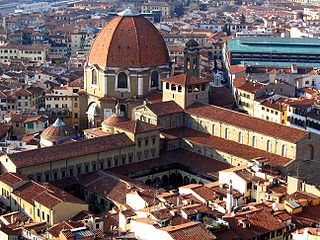
The Medici Chapels are two structures at the Basilica of San Lorenzo, Florence, Italy, dating from the 16th and 17th centuries, and built as extensions to Brunelleschi's 15th-century church, with the purpose of celebrating the Medici family, patrons of the church and Grand Dukes of Tuscany. The Sagrestia Nuova was designed by Michelangelo. The larger Cappella dei Principi, although proposed in the 16th century, was not begun until the early 17th century, its design being a collaboration between the family and architects.

The Agony and the Ecstasy (1961) is a biographical novel of Michelangelo Buonarroti written by American author Irving Stone. Stone lived in Italy for years visiting many of the locations in Rome and Florence, worked in marble quarries, and apprenticed himself to a marble sculptor. A primary source for the novel is Michelangelo's correspondence, all 495 letters of which Stone had translated from Italian by Charles Speroni and published in 1962 as I, Michelangelo, Sculptor. Stone also collaborated with Canadian sculptor Stanley Lewis, who researched Michelangelo's carving technique and tools. The Italian government lauded Stone with several honorary awards for his cultural achievements highlighting Italian history.

Two different crucifixes, or strictly, wooden corpus figures for crucifixes, are attributed to the High Renaissance master Michelangelo, although neither is universally accepted as his. Both are relatively small figures which would have been produced in Michelangelo's youth.
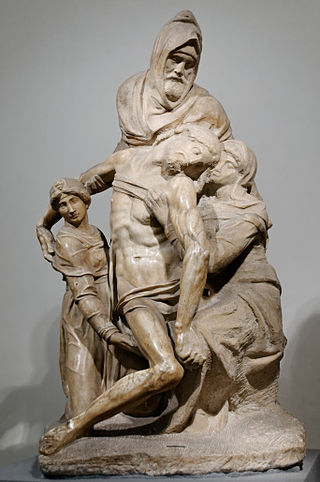
The Deposition is a marble sculpture by the Italian High Renaissance master Michelangelo. The sculpture, on which Michelangelo worked between 1547 and 1555, depicts four figures: the dead body of Jesus Christ, newly taken down from the Cross, Nicodemus, Mary Magdalene and the Virgin Mary. The sculpture is housed in the Museo dell'Opera del Duomo in Florence and is therefore also known as the Florentine Pietà.

Replicas of Michelangelo's David have been made numerous times, in plaster, imitation marble, fibreglass, snow, and other materials. There are many full-sized replicas of the statue around the world, perhaps the most prominent being the one in the original's position in the Piazza della Signoria in Florence, Italy, placed there in 1910. The original sculpture was moved indoors in 1873 to the Accademia Gallery in Florence, where it attracts many visitors. Others were made for study at art academies in the late nineteenth century and later, while the statue has also been replicated for various commercial reasons or as artistic statements in their own right. Smaller replicas are often considered kitsch.
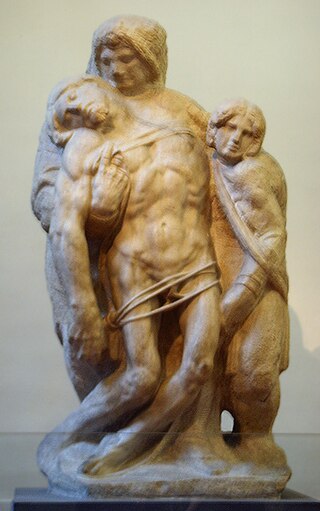
The Palestrina Pietà is a marble sculpture of the Italian Renaissance, dating from c. 1555 and now in the Galleria dell'Accademia, Florence. It was formerly attributed to Michelangelo, but now it is mostly considered to have been completed by someone else, such as Niccolò Menghini or Gian Lorenzo Bernini. According to the Galleria dell'Accademia, the sculpture's "attribution to the master is still somehow controversial".
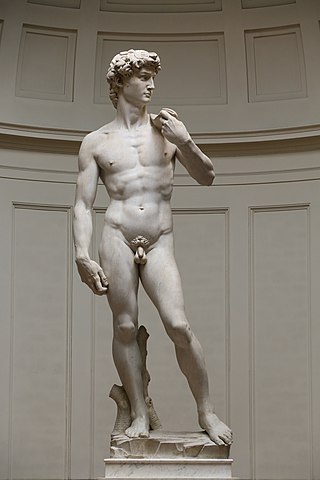
Michelangelo had a complicated relationship with the Medici family, who were for most of his lifetime the effective rulers of his home city of Florence. The Medici rose to prominence as Florence's preeminent bankers. They amassed a sizable fortune some of which was used for patronage of the arts. Michelangelo's first contact with the Medici family began early as a talented teenage apprentice of the Florentine painter Domenico Ghirlandaio. Following his initial work for Lorenzo de' Medici, Michelangelo's interactions with the family continued for decades including the Medici papacies of Pope Leo X and Pope Clement VII.

Giardino delle rose is a garden park in the Oltrarno district of Florence, in Tuscany, Italy. It is located below the Piazzale Michelangelo and offers a commanding view of the city.
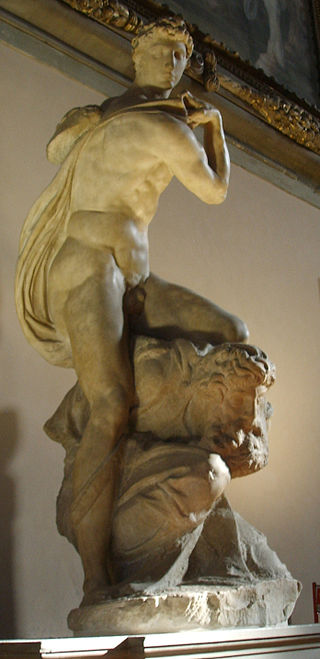
The Genius of Victory is a 1532–1534 marble sculpture by Michelangelo, produced as part of a design for the tomb of Pope Julius II. It is 2.61 m high and is now in the Salone dei Cinquecento of the Palazzo Vecchio in Florence.
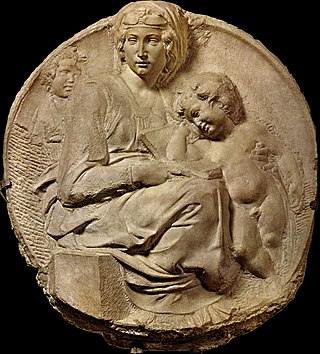
The Pitti Tondo is an unfinished marble relief of the Virgin and Child by Michelangelo in round or tondo form. It was executed between 1503 and 1504 while he was residing in Florence and is now in the Museo nazionale del Bargello in Florence.

Brutus is a marble bust of Brutus sculpted by Michelangelo around 1539–1540. It is now in the Bargello museum in Florence.
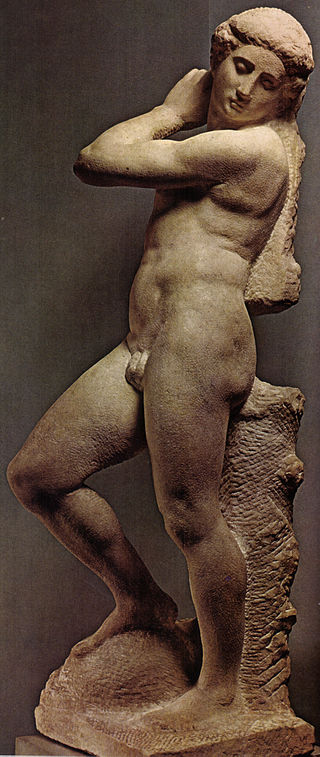
Apollo, also known as Apollo-David, David-Apollo, or Apollino, is a 1.46 m unfinished marble sculpture by Michelangelo that dates from approximately 1530. It now stands in the Bargello museum in Florence.



















